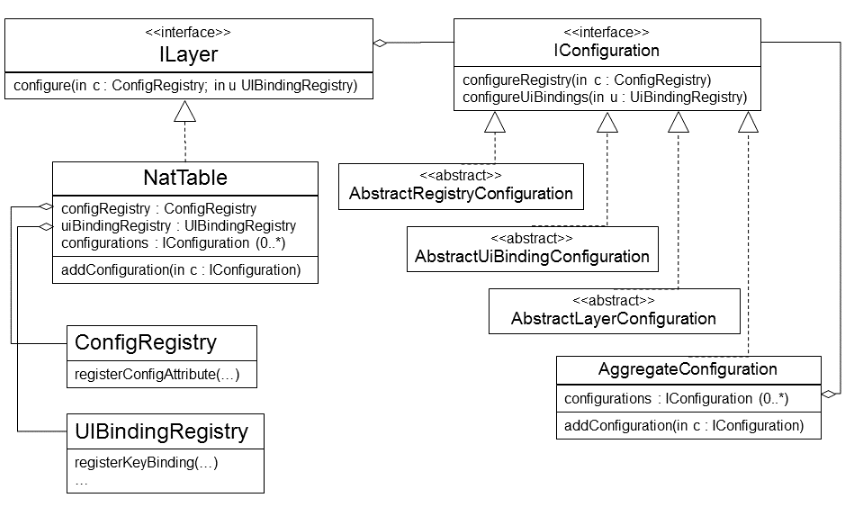# Configuration
NatTable allows to use configuration to customize the styling and behavior of the layers and the table . Every layer typically introduces configurations for the features they add.
Configurations are registered via registries. There are two configuration registries for each NatTable instance:
## `IConfigRegistry`
This is a global object holding the configuration attributes for the following kinds of configuration:
* Styling
* Editing
* Comparators for sorting
* Any other information that should be configurable
## `IUiBindingRegistry`
This is a global object holding the following kinds of configuration:
* Key bindings
* Mouse bindings
## Configuration classes
It is recommended to create separate configuration classes to encapsulate the different configurations. It is also possible to put configurations directly into a registry which is mostly used for dynamic behavior changes at runtime. There are four types of configuration classes:
* `AbstractRegistryConfiguration`
Used to register configuration values to the `IConfigRegistry`.
* `AbstractUiBindingConfiguration`
Used to bind actions to UI interactions via `IUIBindingRegistry`.
* `AbstractLayerConfiguration`
Used to configure an `ILayer`. This typically means to register `ILayerCommandHandler` and `ILayerEventHandler` on a layer.
* `AggregateConfiguration`
Used to combine several configurations in one. Several default configurations delivered with NatTable are implementations of `AggregateConfiguration`. Using this only one configuration instance needs to be registered to add a configuration for styling and ui binding at once.
The following simplified UML diagram shows the relationship between configurations, the NatTable and layers.

## `DisplayMode`
In NatTable a cell can have several modes in which they are displayed. These modes are called `DisplayMode`. This allows to specify different configurations for the same cell in different modes. The following table lists the currently supported display modes.
| DisplayMode | Description |
| :------------------------- | :--------------------------------------------------------------------------------------------------------------------------------------------------------------- |
| `DisplayMode#NORMAL` | The normal state a cell is in if no other state applies. |
| `DisplayMode#SELECT` | The state that shows that a cell is currently selected. |
| `DisplayMode#EDIT` | The state that shows that a cell is currently edited.
**Note:**
This `DisplayMode` is never applied to a cell and is only used for configuration purposes! |
| `DisplayMode#HOVER` | The state that shows that currently the mouse hovers over the cell. |
| `DisplayMode#SELECT_HOVER` | The state that shows that currently the mouse hovers over the cell that is currently selected. |
## Cell labels
NatTable supports conditional configuration via a label mechanism. This means that it is possible to add labels to a cell and register configurations for labels.
Every cell in a NatTable has a `LabelStack`, which is a collection of Strings. Via labels it is possible to tie configurations to specific cells, for example styling a cell with a special error style or configure a checkbox editor for a cell that contains boolean values.
### Default labels
When using a `CompositeLayer` it is possible to set a region label per composition region. You can think of the region label as a default label that is applied to every cell in the corresponding region, e.g. every cell in the body region of a grid has the label `GridRegion.BODY` in its `LabelStack`.
### Labels by layer
Every layer is able to add labels to a cells label stack in the `ILayer#getConfigLabelsByPosition(int, int)` method. This way layer specific stylings are added, e.g. a sort indicator in the column header cells in case the `SortHeaderLayer` is involved.
### Custom labels
It is possible to add custom labels by using an `IConfigLabelAccumulator`. Each layer in the layer composition can take an `IConfigLabelAccumulator` which can be set by calling `AbstractLayer#setConfigLabelAccumulator(IConfigLabelAccumulator)`.
NatTable ships with several default implementations that can be used to register custom labels. Some of them implement `AbstractOverrider` and allow registering of labels for special criteria.
| Default implementation | Description |
| :------------------------------- | :------------------------------------------------------------------------------------------------------------------------------------------------------------------------------------------------------------------------------------------------------------------------------------------------------------- |
| `CellOverrideLabelAccumulator` | Registers a label that is applied in case the specified value is shown in the specified column.
`registerOverride(Object cellValue, int col, String configLabel)` |
| `ColumnOverrideLabelAccumulator` | Register labels that will be added to the label stack of cells in the column of the specified index.
`registerColumnOverrides(int columnIndex, String… configLabels)`
`registerColumnOverridesOnTop(int columnIndex, String… configLabels)` |
| `RowOverrideLabelAccumulator` | Register labels that will be added to the label stack of cells in the row of the specified index.
`registerOverrides(int rowIndex, String…configLabels)` |
| `ColumnLabelAccumulator` | Automatically registers column based labels to the label stack. The labels follow the pattern `COLUMN_` + \. Via the constant `ColumnLabelAccumulator#COLUMN_LABEL_PREFIX` concatenated with the column position, it is possible to register custom configurations for those default labels. |
It is also possible tom create a custom `IConfigLabelAccumulator` to handle situations where the default implementations doesn't match. By implementing `IConfigLabelAccumulator#accumulateConfigLabels(LabelStack, int, int)` it is possible to add additional labels to the given `LabelStack`. You can simply add a custom label by calling `LabelStack#addLabel(String)` which means it will be added to the end of the stack. To ensure the newly added label gets a higher priority the `LabelStack#addLabelOnTop(String)` method can be called, which will add the new label at the first position of the label stack.
_**Note:**_
Setting a label at the top of a label stack doesn’t ensure that no other layer or accumulator adds another label on top afterwards.